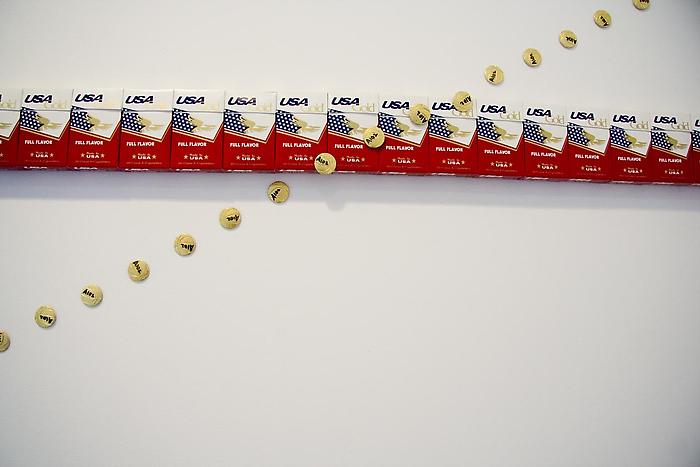This is an archive of the ArtCat Zine, 2007-2009. Please visit our new project, IDIOM.
Mike Quinn at Perry Rubenstein

Winning is Not For Everyone
Mike Quinn
Perry Rubenstein Gallery - 534 W 24 St
27 March - 17 May 2008
Obsessions tend to be unhealthy. Though often personal and familiar to the soul, obsessions occupy so much space in one's mind that living with them becomes obvious, even manageable. Over the years, if an obsession does not wane, the best thing to do is focus your creative energy on it, milk its potential for inspiration and use it to your advantage. After all, it's clearly not going anywhere. I've learned to make mine into vital subjects that I can dissect, expound upon, rethink and recreate. If, however, life becomes a heavy burden, overwhelmed by obsessive tendencies in any direction, things can get increasingly complicated. No one is devoid of problems; scope and gravity may vary, but corrosive tendencies are never wholly unfamiliar. Mike Quinn's new solo exhibition at the Perry Rubenstein Gallery, Winning is Not for Everyone is a personal exploration of some of his more somber thoughts, their resolutions, and an obsessive love for basketball.
Quinn, a Brooklyn-based artist, works obsessively to create repetitions of motions in simple, geometric forms often constituted by the very objects that incite and assuage his otherwise destructive tendencies: psychotropic and anti-depressant medications, tobacco and alcohol. His equally calculated passion for basketball surpasses fanatic love and enters a space in his brain tantamount to thorough knowledge of minutia, careful analysis and assessment of game theory and mathematical probability, and devoted adherence to the games and its players. In short, he is obsessed. When one obsession became sour and destructive, the other was there to fill the gaps created in the healing process of giving up something you desperately want. Intimate, emotional and cathartic, Quinn's work speaks about what happens when love's many forms mutate and take on new faces, ones that can be frightening and isolating. His thoughts and careful contemplations comprise the ongoing story of his work.
In his site-specific installation Keeping Up Appearances Can Be a Drag, Quinn delineates the gravity point with countless empty packs of USA Gold Cigarettes, a shitty no-name brand whose pathetically ostentatious label keeps up the quintessential spirit of American greatness, disingenuous at best, but always glossed over with gold. Gold varsity pins graph an upward line; while the objects should be falling, they do quite the opposite, presumably because each pin represents an anti-depressant, with the prescription code scrawled in ink on every single one of them. Meds make even the greatest of losses possible. When the bottom seems imminent, the solution doesn't need to be despondently bitter. While another may accuse Quinn of coy derision, the reality is that the artist remains ambivalent: he has his life back because he was able to forsake the obsessive elements of it that were killing him. He also understands that social decorum, like USA Gold Cigarettes and everything their name and label implies about our culture, can be synthetically constructed, like moods. In mapping the physics of a moving basketball, tracing the velocity and configuring its trajectory through forms and lines, the disappointment of loss is impending but never overstated. The cornucopia of pills, in their medley of colors, represent the mitigating factor inasmuch as they symbolize another obsessive force guiding his life.
Quinn's work is multifaceted and layered with personal references that span both his vast repertoire of basketball knowledge and collection of personal memories of loss, addiction, pain and harping obsessions. These strangely familiar, at times comforting forces reflect a thorough study in introspection; in shedding light through meticulously constructed works, Quinn finds his personal ablution in a liturgy of disparate yet codependent parts, all of which create his obsessively methodical trajectory.
ZINE
HOME
TIPS / COMMENTS
CATEGORIES
CONTRIBUTORS
- Greg Afinogenov
- B. Blagojevic
- Adda Birnir
- Susannah Edelbaum
- Julie Fishkin
- Paddy Johnson
- Jessica Loudis
- Christopher Reiger
- Andrew Robinson
- Peter J. Russo
- Blythe Sheldon
- S.C.Squibb
- Hrag Vartanian
